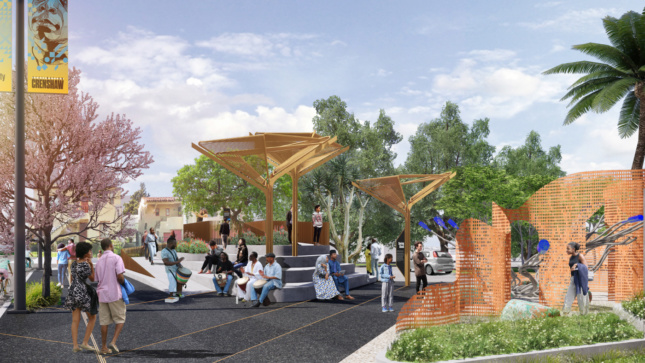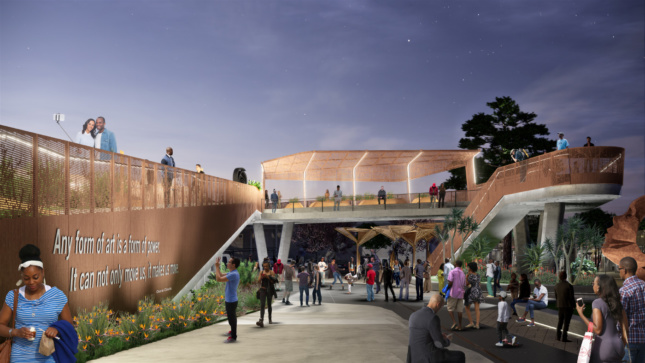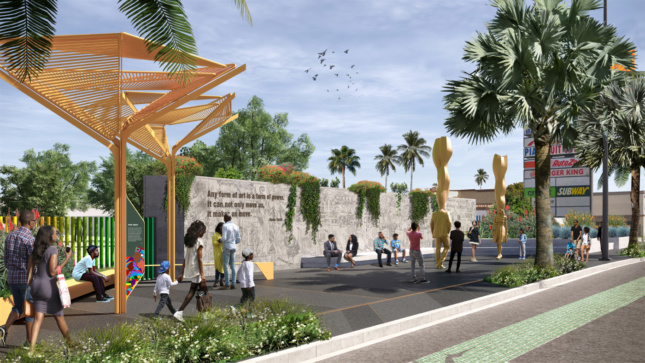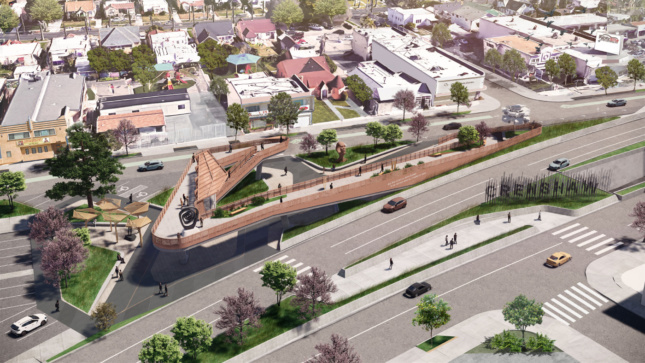A long drive through Los Angeles, a city famed for both its car culture and the superlative diversity of its residents, will take you through a generous number of officially designated ethnic and cultural enclaves: Little Tokyo, Chinatown, Little Ethiopia, Persian Square, Historic Filipinotown, Olvera Street, Little Armenia and neighboring Thai Town, and Koreatown, a district so large and so dense that it comprises an entire major neighborhood and surrounds a separate ethnic enclave in the form of Little Bangladesh.
But as pointed out by Marqueece Harris-Dawson, a Los Angeles City Council member who represents District 8 in the western section of South Los Angeles, this sprawling patchwork of city-christened cultural districts omits one of L.A.’s largest, oldest, and most established communities: that of Black Angelenos.
“There’s nothing in L.A. that officially designates [a cultural district] for the group that’s been here the longest outside of Native Americans,” Harris-Dawson told The Architect’s Newspaper. “Black people founded the city of L.A.” (Harris-Dawson is referring to the Pobladores, the group of 44 settlers, half of whom were of at least partial African descent, who established the city in 1781.)

That’s all set to change, however, with Destination Crenshaw, a project spearheaded by Harris-Dawson that broke ground along Crenshaw Boulevard in the South L.A. neighborhood of Hyde Park this past February.
Spanning 1.3 miles—or 2.6 miles, if you’re counting both sides of the street—along an over-12-block stretch of Crenshaw Boulevard’s historic commercial core, Destination Crenshaw will entail infrastructural and lighting improvements, facade rehabilitation, landscaping, community gathering spaces, “unapologetically Black” public art, and more. It’s easiest thought of as an open-air linear art and history museum celebrating South L.A.’s African American community.
Slated to feature over 100 permanent and rotating street-side artworks from established and emerging Black L.A.-based artists, Destination Crenshaw will be an experience that has some of the narrative-driven qualities of a museum but is ultimately rawer, more dynamic, and liberated from the constraints of four walls.

The project was born from urgency as a direct response to community uproar surrounding the expansion of the Los Angeles Metro Rail system. The Crenshaw/LAX Line, an under-construction $2.1 billion light-rail line that will run at grade along this stretch of Crenshaw Boulevard, has long been a source of apprehension for residents and community leaders, particularly with regard to the impact that a major transit project could have on local small businesses, homeowners, and the fabric of the community. Transit-spurred gentrification was and still is a major concern. Yet some, including Harris-Dawson, have come to view the arrival of the Crenshaw/LAX Line, which includes two new Metro stations bookending Destination Crenshaw, as an opportunity to create something new. And that something has ultimately taken the form of a streetscape unlike anything that’s been attempted before.
“When you simplify it, we’re just building a platform to showcase and grow the things that already come out of the Black community,” said Harris-Dawson. “What we’re doing isn’t rocket science—except for the amount of art, because that’s quite unprecedented.”
In addition to implementing long-sought infrastructural improvements, including bike racks, additional parking, and new, “culturally stamped” sidewalks, Destination Crenshaw will, in the words of Harris-Dawson, use public art and design to illustrate “the story, culture, and roots of this neighborhood in a way that you can hear, see, touch, and feel so that it actually reflects where you are.”

Funding for the $100 million project has come from a range of sources, including private backers, the City of Los Angeles, the State of California, and the Los Angeles County Metropolitan Transportation Authority, which contributed $15 million earmarked for a large, Metro station–adjacent park at its northern end.
To aid in envisioning a dynamic solution that would protect and support Black-owned businesses along Crenshaw Boulevard while also introducing new elements spotlighting South L.A.’s profound global cultural influence, Council District 8 turned to the Durham, North Carolina–based branch of Perkins and Will. Leading the Destination Crenshaw design team is Zena Howard, a protégée and colleague of the late Phil Freelon. Most notably, Howard served as senior project manager for Freelon Group on its work alongside Adjaye Associates at the Smithsonian’s National Museum of African American History and Culture in Washington, D.C. (Perkins and Will acquired Freelon Group in 2014, five years before Freelon’s passing.)
“Our practice focuses on using the built environment to bring to light and support communities and their untold stories,” said Howard, who is currently managing director of Perkins and Will’s North Carolina office. “And oftentimes these are communities that have been disenfranchised or otherwise marginalized or divided.”
“There really isn’t a true precedent for this,” Howard added. “There are some projects that are in the same ilk—people cite the High Line and other things—but there are none that tell a consistent story that had not really been put forth, and that are community-driven and inspired in the way that this is.”
The opportunity for extensive community engagement and collaboration with a vast and diverse number of partners was immensely appealing to Perkins and Will. “It excited us…[as] a way to have architecture partner with so many different aspects of our community, culture, and society to help bring this story to light,” Howard explained. “We were up for doing something that had never been done before.”

Crucial to the engagement process was working alongside Destination Crenshaw to form a diverse, multigenerational design advisory council or, as Howard referred to it, an “‘A’ team of thought leaders, artists, and people who have lived in the community for decades.”
Among the 20-person-strong community partner team is gardener, artist, and community activist Ron Finley; Amanda Hunt, director of education and senior curator of programs at the Museum of Contemporary Art, Los Angeles; Felicia Filer, public art division director for the City of Los Angeles Department of Cultural Affairs; filmmaker and activist Ben Caldwell; and street artist ArcherOne. Rapper, activist, and Crenshaw native Nipsey Hussle was also intimately involved in the planning and advisory stages of the project before his death in March 2019.
These are “people on the front lines of Black L.A. art culture,” Harris-Dawson said. “Some of them are artists, some are curators, historians, community organizers, and urban planners. But they all have some tie together…and they’re real community stakeholders.”
“We chose them because you have to have real authoritative pushback when people design something that does not reflect you,” Harris-Dawson added.
The unifying design narrative that emerged from the monthslong charrette process was “Grow Where You Are Planted.” Praising and encouraging endurance against all odds, the design uses African star grass as a central motif. Moving south to north along Crenshaw Boulevard, Destination Crenshaw is divided into four distinct thematic nodes, or “lenses,” that together tell the story of Black Los Angeles’s past, present, and future. Each node features small parks, interactive installations, and, of course, an abundance of public art.
Commencing at the planned Hyde Park station, at Slauson Avenue and Crenshaw, is the “Improvisation” node, which was inspired by Hussle and celebrates the spirit of creativity and ingenuity in the face of limited resources. Beginning at 54th Street is the “Firsts” section of Destination Crenshaw, which uses the story of Biddy Mason, one of L.A.’s first female Black landowners, to spotlight numerous other trailblazing individuals and events that came from or took place in South L.A. At 50th Street is the start of the “Dreams” node, which was inspired by the life and career of pioneering African American architect Paul R. Williams, and includes the Crenshaw Wall, a mural-clad 800-foot wall/canvas that dates back to the 1970s. Around the planned Leimert Park station, on Vernon Avenue, Destination Crenshaw concludes in the spirit of “Togetherness,” which, as Howard explained, is “about the ability of this community to come together to celebrate, to resist, and to mourn in times of happiness and protest.” This northernmost section of the project will include its centerpiece, Sankofa Park, a large, open public space straddled by an overlook structure whose form takes its inspiration from the symbol of the mythical Sankofa bird, which flies forward while also looking backward.
In addition to Sankofa Park and a multitude of pocket parks punctuating Destination Crenshaw, landscape design firm Studio-MLA is overseeing a major tree planting effort. Nearly all the trees along this stretch of Crenshaw Boulevard were removed by the city in 2012 to make way for the space shuttle Endeavour as it was hauled 12 miles through the streets of L.A. to the California Science Center. Although trees were replanted in other areas of the city that the shuttle traveled through, Crenshaw Boulevard has remained woefully barren.
“This is also an environmental equity project,” said Howard, referencing the landscape design. “We are also reforesting, bringing back 822 trees to beautify this boulevard and to make it a humane place to be.”
As Kenneth Luker, the project’s lead design principal with Perkins and Will, explained, one of the main challenges in conceiving Destination Crenshaw revolved largely around scale.
“How to create a unified experience across such a large urban landscape was challenging when we consider how many other components of the urban context need to coexist with this project, such as the Metro, Crenshaw Boulevard, and many private landowners,” Luker said. “The ‘connective tissue’ of our concept was designed specifically to unite this urban landscape of multiple pocket parks, art installations, and exhibits.”
Beyond the interventions by Perkins and Will, Destination Crenshaw is also investing in a facade improvement program for existing small businesses along the corridor, starting with soul food restaurant Dulan’s On Crenshaw. This is important, Harris-Dawson pointed out, because “we want these businesses not only to survive with the new train coming but to thrive.”
With an estimated completion date in early 2021, Destination Crenshaw is scheduled to greet riders of the Crenshaw/LAX Line when that project wraps up around the same time. And while concerns linger over how the new presence of mass transit will play out in this pocket of South Los Angeles in the near future, Destination Crenshaw will have at least already made a bold and beautiful mark in a community whose cultural influence—in visual art, music, and film—spans the world but has never been officially saluted in its own backyard.
“While this project can’t resolve all of that,” said Howard, referring to the potential for transit-oriented development and real estate turnover resulting from the new Metro line, “we can mark this area culturally with icons, art, architecture, and landscape design that speaks to and memorializes this community and their contributions regardless of any change that may happen later.”











